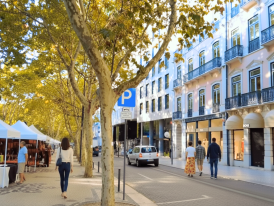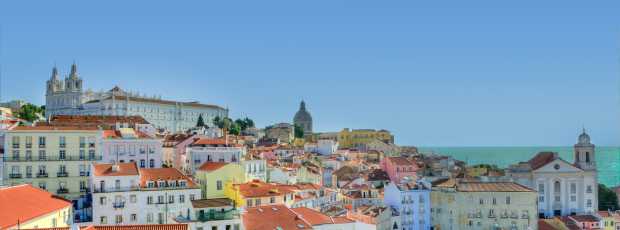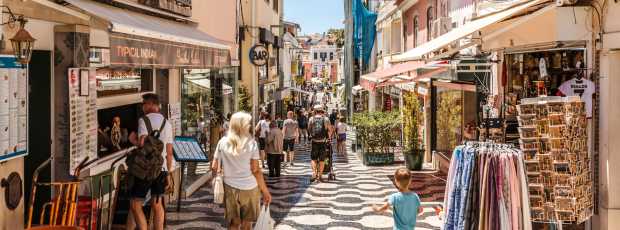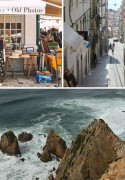Absolutely amazing day. Our tour guide Alex was the best ever who has so much knowledge and passion for the city and its history it just added to our experience.Joanna, Europe, 2025
Explore Vancouver like a local on a private tour
Real neighborhoods, local hangouts, your pace
Table Of Contents
- You Haven’t Really Done Lisbon Without These Neighborhoods
- Classic Neighborhoods With a Local Perspective
- Overrated: Keep, Tweak, Or Go Alternative
- Foodie And Market Neighborhoods
- Creative And Emerging Districts
- Family-Friendly And Relaxed Corners
- Nightlife And Youth Culture Zones
- Best Neighborhood Explorations
- Practical Tips for Navigating Neighborhoods in Lisbon
- Frequently Asked Questions About Lisbon Neighborhoods
- Final Thoughts On Finding Your Lisbon

Lisbon rooftops from Castelo de São Jorge with Tagus River view
Lisbon isn't one place. It's a patchwork of Lisbon neighborhoods, each with its own heartbeat. From the castle ridge where Castelo de São Jorge watches over red-tiled rooftops to the Tagus River below, the city is stitched together by cobblestone streets, balconies draped with laundry, and café chatter.
My guide shares where Lisboetas actually go. Places within walking distance of the icons, but outside the constant shuffle of tour groups.
Whether you're a first-time visitor looking for the best neighborhoods to stay in Lisbon, or returning to dig deeper, I'll show you the Lisbon neighborhoods that capture both the city's soul and its practicality.
Most visitors land in Bairro Alto for the nightlife, or book hotels along Avenida da Liberdade for the convenient location.
But the real Lisbon lives elsewhere too, in narrow streets where neighbors still greet each other by name, in parks full of local families, and in tiled markets where fishmongers call out the day's catch.
There are plenty of Lisbon experiences that every guide mentions, but I find the city shows itself better through neighborhood rhythms than tourist schedules.
Want to Experience Lisbon Firsthand?
Step into the neighborhood, scene, or story with someone who knows it inside out.

Leafy streets and Jardim da Estrela park, with families and quiet moments
You Haven’t Really Done Lisbon Without These Neighborhoods
I start with the places that feel like Lisbon at street level. These neighborhoods are where daily rhythms beat louder than the postcards, where you can walk from a miradouro to a market and still hear neighbors greet each other by name.
If you only have time for a few stops, make them here and let the rest of the city unfold within walking distance.
Mouraria: Where Fado Was Born, And The World Comes To Eat
Mouraria holds a special place in my heart because it shows two sides of Lisbon at once. Our musical roots meet our global future. This is where fado was born around Rua do Capelão and Largo da Severa, where some of the city’s best international food happens today.
Walk these narrow streets and you step into fado’s origin story.
The Escadinhas de São Cristóvão carry the Fado Vadio mural that celebrates the neighborhood’s voice. On Thursday evenings, you may still catch impromptu singing that drifts from a doorway when neighbors gather. It is unpolished, and it feels true.
Follow your nose to Rua do Benformoso, and you find Goan Cape Verdean and Bangladeshi cafés that have made the Portuguese capital home. Aromas of curry and grilled fish mix with caldo verde and grilled sardines, and the blend tastes like Lisbon’s future.
When you need a pause, walk to Jardim da Cerca da Graça between Graça and Mouraria for kiosk coffee and castle views, and then slip back to the side streets for another plate and another story.
There are so many things to do in Mouraria if you want the Lisbon neighborhoods that locals actually use.
Mouraria's Not Just a Place on a List
Experience it through hidden corners and stories most visitors miss.
Balconies Above The City In Graça And Monte Agudo
When I need to remember why I love Lisbon, I climb to Graça. In my opinion this is one of the very best neighborhoods and it spreads over one of the seven hills.
The views make every step worth it. Most visitors flock to Miradouro da Senhora do Monte for panoramic views, but I prefer walking a little higher to Monte Agudo, where locals sip coffee and take in the sunset without the crowds.
Daily life keeps the charm steady. Jardim da Cerca da Graça works like a living room for the area with kids on the grass and kiosk coffees under the trees.
Mornings start along Rua da Graça with grocery runs and warm bread. Late light turns the tiled rooftops gold, and the skyline feels endless. Graça holds the postcard and the pause. Monte Agudo is the secret sunset spot.
Campo de Ourique: Where Lisbon Shops And Eats At Home
If Mouraria shows cultural complexity and Graça showcases beauty, Campo de Ourique reveals Lisbon’s appetite. This flat grid of tree-lined streets wraps around the Mercado de Campo de Ourique, a neighborhood in Lisbon where daily life revolves around eating well and talking to the people who feed you.
The market runs on everyday rhythms, and it feels different from the Time Out Market. Mornings bring fish and vegetables and flowers. Evenings bring glasses of wine and friends standing at counters.
Beyond the market, the streets feel like a small town inside the Portuguese capital. Paper shops, bakeries, and family restaurants set an easy rhythm that suits families.
The terrain is flat, which makes it a genuinely convenient location. Jardim da Estrela sits within a short stroll for shade and a playground pause. Tram and bus connections link you back to the center when you finally decide to leave.
Estrela And Lapa For Garden Calm In The City
Estrela and Lapa give you level, leafy streets in a hilly place like Lisbon. Jardim da Estrela feels like a neighborhood living room where families arrive with strollers on weekend mornings and older neighbors feed pigeons on quiet afternoons.
I grew up climbing the bandstand steps, and I still stop for kiosk coffee with the basilica in view.
Lapa spills downhill from Estrela with embassy residences and quiet townhouses. Small boutique hotel conversions offer private rooms with character that feel part of the street rather than apart from it.
The terrain is kind to knees, which suits a family-friendly atmosphere and slow evening walks.
You are walkable to Baixa and a short tram or regional train ride to Belém. Trams 25E and 28E place public transportation within easy reach, so exploring Lisbon stays simple.
Estrela offers leafy calm in the middle of central Lisbon, and I return here whenever I want the city to feel like a village again.
I love Alfama most in the blue hour when delivery carts rattle and windows open to the first coffee.

Tree-lined Avenida da Liberdade with designer shops and grand buildings
Classic Neighborhoods With a Local Perspective
Before diving into my favorite local spots, let's acknowledge the popular neighborhoods every guide mentions. Understanding them helps you appreciate why the alternatives feel so refreshing.
Alfama, The Postcard Old Town
The Alfama district deserves its fame, and it earns its crowds. Narrow streets climb past whitewashed corners and cobblestone streets toward Castelo de São Jorge, with sudden viewpoints over the Portuguese capital.
You can still slip into authentic fado houses on the side streets and feel the old city gather around a guitar.
I love Alfama most in the blue hour when delivery carts rattle and windows open to the first coffee.
Sunset crowds fill the lanes later, and some spots lean into tourist traps dressed as traditional tascas. The hills bite even if you wear comfortable walking shoes, so take your time and pause for the views.
If you want the classic shot with fewer voices, go early. Walk the ridge to the castle gate or circle back down a quieter lane and let the city reveal itself one tile at a time.
You Can Taste Lisbon's Best Wine
A local can take you to the right spots for amazing taste experiences.
Baixa And Chiado Central Elegance
The Chiado neighborhood and Baixa form Lisbon’s commercial heart. Cobblestone streets link grand plazas and old bookstores and cafés that survived the great earthquake. The central location makes this an easy base for exploring Lisbon on foot.
I drift through Rossio Square and Praça da Figueira for people watching, then ride the metro lines or pick up tram connections when my legs tire.
The Elevador de Santa Justa delivers a wide sweep over Lisbon’s downtown, and the side streets keep the great shopping coming without losing character.
When I want quiet, I cross into São Bento or Santos. The rhythm softens while the center stays close.
Bairro Alto: The Nightlife Hub
By day, Bairro Alto feels like a quiet grid of tiled houses. By night, it transforms into Lisbon’s buzzing nightlife hub, where bars spill out onto cobblestone streets, and music drifts through the air. It delivers exactly what night owls and first-time visitors expect.
The energy is real, and the hilly neighborhood adds to the mood. You are in easy walking distance of central attractions, which is why the crowds build fast.
Weekends run loud and some spots lean touristy, so I start here for the buzz then drift to Intendente or Príncipe Real for more space and better conversation.
Avenida da Liberdade The City's Boulevard
This tree-lined avenue connects downtown Lisbon to the newer parts of the city, and it’s home to restored palaces now turned into hotels. It offers a central location, flat sidewalks, high-end designer shops, and the occasional rooftop pool.
Avenida da Liberdade works well if you’re looking for convenience, easy public transportation, and great shopping. But if you’re seeking café gossip and market mornings, head to Estrela or Campo de Ourique.
Use Avenida da Liberdade for your shopping excursions, but let these quieter neighborhoods provide the true Lisbon experience.
Too Many Lists, Not Enough Clarity?
We make exploring simple by connecting you with someone who knows the city and helps you spend your time on what matters to you.

Castelo de São Jorge hilltop fortress with city views
Overrated: Keep, Tweak, Or Go Alternative
Some Lisbon icons are worth it, but the win comes from timing and small adjustments.
Here I keep what works, tweak what needs it, and offer smarter swaps like Alfama at dawn, the Elevador de Santa Justa via the upper deck, and a party start in Bairro Alto before drifting to Intendente or Príncipe Real.
Alfama: Tweak the timing, not the plan
I love Alfama’s narrow streets, just not at sunset. Go early morning for the same glow, then save fado for Mouraria. If you’re set on Castelo de São Jorge, book ahead and aim for the first or last slot.
Elevador de Santa Justa: Keep the view, skip the line
Fun once, the queue isn’t. If you have the Lisboa Card, ride it. The elevator is included. Otherwise, walk up via Largo do Carmo to reach the upper walkway and the viewing deck for the same panorama over Lisbon’s downtown and the Tagus River.
Bairro Alto: Party if you must, but sleep elsewhere
Still the nightlife hub for night owls. Start here, then switch to Intendente or Príncipe Real for cocktails and space. For real sleep, stay in Estrela or Campo de Ourique.
Tram 28E: Iconic photo, inefficient ride
Great pictures, crowded cars. Ride before 8 AM or after dinner, otherwise take 12E (similar hilly streets) or go by metro or on foot. Service can be rerouted for works, so be sure to check Carris on travel days.
Avenida da Liberdade: Convenience over community
Perfect central location, flagships, boutique hotel perks (even a rooftop pool). Flat sidewalks and public transportation on your doorstep, but it’s a boulevard, not a bairro. For café gossip, try Estrela or Alvalade.
Castelo de São Jorge: Buy ahead, roam smarter
Keep it. Just prebook. After the view, drop toward Graça. Senhora do Monte for the postcard, Monte Agudo for breathing room.
Don’t ditch the big hitters. Tweak the hour, change the approach, or swap the street. Keep the magic, lose the hassle. If you want the quieter side with real character, start with my guide to hidden gems in Lisbon.
Because No Two Travelers Are the Same
We help you shape a city day that matches your pace, your style, and your curiosity, not a fixed route.
Colorful street in Arroios with family-run global restaurants
Foodie And Market Neighborhoods
Food defines daily life in these Lisbon neighborhoods, and each area offers distinct culinary experiences.
Arroios And Anjos International Flavors
These other neighborhoods showcase Lisbon's diversity through Ethiopian injera bread, Nepali momo dumplings, and Bangladeshi curry houses. Family-run restaurants serve communities that have brought global flavors to Portuguese ingredients.
Alvalade Traditional Tascas
The Mercado de Alvalade anchors a food scene focused on traditional Portuguese cooking. Local tascas serve grilled fish and pastéis de nata to neighbors who've been regulars for decades.
Lisbon's food culture lives in its neighborhood markets and family tascas.
Hungry to Try Lisbon's Delicious Food Yourself?
Taste and explore the flavors locals actually love.

Colorful trams from the Carris tram museum
Creative And Emerging Districts
We are talking about Lisbon neighborhoods where industrial bones meet new ideas and where the Tagus River gives space for studios, galleries, and small venues.
Think weeknight workshops that spill into weekends, beer in converted factories, and public transportation that makes it easy to dip in for an afternoon and stay for the evening.
Marvila And Beato: Where Warehouses Become Art
On the eastern edge by the Tagus River, Marvila and Beato feel like Lisbon is testing its future. Former industrial areas have turned into studios, galleries, event spaces, and converted factories where young artists work beside craft breweries like Dois Corvos.
The buildings keep their bones and offer spacious rooms that suit big ideas and late conversations.
Weekdays stay quieter while people make things. Weekends switch on with openings, markets, and music. The mix draws local creatives and curious visitors.
You get easy access from the center with public transportation and the long river light once you arrive. It is a pocket of the city where experiments meet everyday life.
Curious What You Won’t Find Online About Lisbon?
Discover the side only locals talk about.
Alcântara: Where Trams Live
Alcântara stretches along the river under the 25 de Abril bridge and mixes industrial heritage with new cultural life. The Museu da Carris sits inside a working tram depot where Lisbon’s tram history is kept alive, and the old cars still smell of grease and wood.
Warehouses nearby hold small studios and design spaces, and the Tagus breeze keeps the streets cool.
The neighborhood keeps a working character even as galleries and cafés move in.
Side streets carry workshops and family shops, and the riverside gives you a long walk with bridge views.
I come here for an easy afternoon near the water and leave with tram grease on my hands and a head full of ideas. Alcântara is a tram history with riverside calm.

Mercado de Campo de Ourique with fresh produce and lively atmosphere
Family-Friendly And Relaxed Corners
I come here when I want Lisbon to slow down and feel like home. These family-friendly neighborhoods in Lisbon trade noise for parks, markets, and wide sidewalks.
Campo de Ourique stays flat and social around its market and cafés. Alvalade runs on an everyday rhythm with strong public transportation and streets made for strollers. Madragoa keeps a village soul by the river and still sits within walking distance of central Lisbon.
Campo de Ourique: Market Fresh
The Mercado de Campo de Ourique provides the neighborhood's culinary anchor.
Morning visits reveal pristine fish and seasonal vegetables, while evening transforms the space into an informal dining where neighbors share wine.
Alvalade: Mid-Century Everyday
Most guidebooks skip Alvalade, and that is why locals love it. This neighborhood in Lisbon was planned in the 1940s with wide streets and a calm rhythm that makes daily life feel easy.
Mercado de Alvalade is the heart where mornings mean fish and vegetables, and where lunch brings office workers to tascas for grilled fish and salad.
Avenida da Igreja runs as the main street with cafes and bookstores, and small businesses that know their neighbors. Seniors settle in for afternoon coffee.
Students read at outdoor tables. It is an affordable option with excellent public transit connections and wide sidewalks that suit strollers and comfortable walking shoes.
When I want Lisbon without the performance, I come here and let the day move at its own pace.
Madragoa: Fishing Village Soul
Madragoa keeps something rare in the Portuguese capital. A fishing village mood inside the city. Narrow streets curve between tile cottages and small patios.
Old tascas grill sardines for neighbors who have shared tables for decades.
Walk slowly, and the time slips away. Laundry hangs above your head. Bica coffee arrives in small glasses at corner cafés.
I still pass a tasca where Senhor João chalks the menu by hand, and I remember staring over the counter as a kid.

Intendente Square at night, azulejo tiles and cafés
Nightlife And Youth Culture Zones
When I go out at night, I skip the postcard and follow the music. These Lisbon neighborhoods mix small venues with good cocktails and easy street talk.
They keep room to breathe. Intendente and Anjos bring a global kitchen and a young crowd that lingers on squares after shows.
Príncipe Real pours polished cocktails for night owls who want style without chaos, and Marvila adds taprooms and brewery patios for long conversations.
Intendente And Anjos: Where Global Lisbon Meets
Intendente and Anjos feel like contemporary Lisbon at street level. Traditional Portuguese life meets new communities, and the mix shows up in the cafés and on the squares.
I come for the late buzz and stay for the conversations that start at the curb.
Walk toward Arroios, and the global kitchen opens up. Ethiopian injera and Nepali momo sit beside Bangladeshi curries, and the flavors fold into the rhythm of the neighborhood.
The ceramic façades around Intendente Square glow at night, and nearby streets reveal new cultural centers and easy bars where locals and recent arrivals share tables. This is where Lisbon’s youth culture grows without losing its roots.
Príncipe Real: Cocktail Culture
Príncipe Real stands out among Lisbon's nightlife alternatives to the crowded Bairro Alto scene. This elegant neighborhood offers upscale bars serving creative cocktails to a stylish crowd that appreciates quality ingredients.
Príncipe Real attracts locals seeking sophisticated nightlife without the tourist chaos, making it perfect for a romantic getaway evening.
The tree-lined square, originally built in the 19th century, provides a refined atmosphere that contrasts sharply with the party-focused energy elsewhere.
Marvila: Brewery Scene
Craft breweries offer beer in industrial settings that feel both relaxed and cutting-edge. Weekend evenings bring locals for pints and conversation.
For a local night out, skip Bairro Alto and head east to Intendente or uphill to Príncipe Real.
25,902+ 5-Star Reviews and Counting
Trusted and recommended by travelers worldwide, including 99% on Google and TripAdvisor.

Ajuda Palace terrace with Tagus River and rooftops
Best Neighborhood Explorations
These neighborhoods sit within easy walking distance of central Lisbon or a quick hop by public transportation. You get markets and miradouros and streets with real routines. The Tagus River stays close, and the city feels lived in rather than staged.
Ajuda Royal: Hill Above the River
Ajuda occupies high ground above Belém, offering royal history and neighborhood tranquility. This high neighborhood provides close proximity to Lisbon's major sights while maintaining local character.
Palace Life
The Palácio Nacional da Ajuda dominates the area, a neoclassical palace showcasing 19th-century royal life.
While many who have visited Lisbon seek out the major monuments like Torre de Belém or even lesser-known sites like the Roman Theatre ruins (Teatro Romano) near the Lisbon Cathedral in Alfama, Ajuda's palace offers royal grandeur without the crowds.
The palace gardens offer views over the Tagus River, creating an ideal spot for those seeking a romantic getaway experience away from the tourist masses.
Ajuda: Daily Life and Neighborhood Charm
Away from the palace, Ajuda feels like a village perched above the city. Traditional tascas serve lunch to local workers, while small groceries maintain rhythms that feel unchanged from decades past.
It's a short walk downhill to Belém's monuments like Torre de Belém, but the return climb ensures most tourists stay below.
This creates a nice mix where you can access major sights yet retreat to genuine neighborhood life.
Imagine Experiencing Lisbon for Real
A local can show you the vibe, flavors, and hidden gems up close.

Wet cobblestone street in Lisbon with steep hill and tram tracks
Practical Tips for Navigating Neighborhoods in Lisbon
Lisbon rewards small choices. Wear comfortable walking shoes and pace the hills. Use the metro lines and buses when the trams fill up. For a wider shortlist that still feels local, scan things to do in Lisbon before you map your day.
Pick a central location that still sleeps well or base in Estrela, Campo de Ourique, or Alvalade and stay within easy walking distance of the icons. Plan mornings for the busy sights and keep afternoons for cafés and side streets.
Pack The Right Shoes
Comfortable walking shoes with a good grip are essential. Lisbon's cobblestone streets become slippery when wet, and the city's hilly streets demand footwear that provides ankle support.
Trust me on this one. I've learned it the hard way, sliding down Rua da Bica in completely wrong shoes during a rainstorm.
Understand Transportation Reality
Trams are scenic but crowded. Metro lines and buses provide more reliable public transportation for actually moving around the city efficiently.
I love the romance of Tram 28 as much as anyone, but when I'm running late for dinner with friends, I take the metro. Sometimes being practical beats being picturesque.
Choose Your Base Wisely
Central location isn't always ideal if it means constant crowds and higher prices. Well-connected neighborhoods like Estrela, Campo de Ourique, or Alvalade offer better value and more authentic experiences.
Lisbon rewards slow walking, early starts, and choosing neighborhoods based on character rather than just proximity to famous sights.
How Is Lisbon Laid Out?
Lisbon folds over seven hills above the Tagus River. The flat bowl of Baixa anchors the center with Rossio Square and Praça do Comércio in Lisbon’s downtown, rebuilt after the 1755 earthquake.
From here, the Elevador de Santa Justa lifts you toward the Chiado neighborhood while narrow streets spiral up to the ridge.
Castelo de São Jorge crowns that ridge, and the Alfama neighborhood spills down its slopes. The Sé de Lisboa sits partway up and marks where medieval Lisbon began.
Visitors chase Lisbon Cathedral and castle views while locals slide into nearby streets that keep the same mood with fewer crowds.
West along the river, the ground levels out toward Belém. North of Baixa, Avenida da Liberdade runs like a spine into newer districts where the grid turns regular and everyday life takes over.
Knowing this map helps you pick neighborhoods that match your hill comfort and your need to stay close to Lisbon’s major sights.
Before You Go, Talk to Someone Who Knows
A local video call helps you plan the trip that’s right for you.
Frequently Asked Questions About Lisbon Neighborhoods
1) What Are the Best Lisbon Neighborhoods for a Central Location but Quiet Nights?
Estrela and Campo de Ourique offer the ideal combination. Both provide easy access to central attractions via public transportation while maintaining peaceful evening atmospheres.
2) Where Can I Get Castle Views Without the Crowds?
Graça provides multiple viewpoints, including the secret Miradouro do Monte Agudo, where locals watch the sunset without fighting tour groups for space.
3) Which Neighborhoods Are Within Walking Distance of Downtown but Feel Local?
Mouraria, Madragoa, and Santos are all within easy walking distance of central Lisbon while preserving distinct neighborhood character.
4) What Are the Best Alternatives to Bairro Alto for Nightlife?
Intendente offers bohemian sophistication, while Príncipe Real provides upscale cocktail culture that many who have visited Lisbon before prefer over the crowded Barrio Alto experience. Marvila adds craft brewery scenes. All offer more space than Bairro Alto's crowded bars, and Príncipe Real particularly appeals to couples seeking a romantic getaway atmosphere.
5) Which Lisbon Neighborhoods Are Most Family-Friendly?
Campo de Ourique, Estrela, and Alvalade excel for families. Campo de Ourique's flat streets ease stroller navigation, Estrela's park provides playground space, and Alvalade's wide sidewalks create suburban comfort.
6) Is Belém Good to Stay In, or Is Ajuda Better?
Ajuda offers superior value. While Belém focuses on monuments and can feel tourist-heavy, Ajuda's elevated position provides a great location for accessing attractions while maintaining a genuine neighborhood atmosphere.
7) Where Can I See Lisbon's Creative Side?
Marvila and Beato showcase contemporary creativity in converted industrial spaces. Artist studios and craft breweries offer authentic encounters with Lisbon's cultural future.
8) Which Neighborhood Markets Are Worth Visiting?
Mercado de Campo de Ourique combines traditional stalls with modern dining, while Mercado de Alvalade preserves authentic local commerce. Both serve neighborhood communities rather than tourist crowds.
9) What Is the Most Authentic Fado Neighborhood?
Mouraria remains fado's spiritual home while avoiding tourist-trap performances. Thursday evening impromptu sessions provide authentic musical experiences where neighbors still gather to sing.
10) Which Neighborhoods Have Wide, Walkable Streets?
Alvalade and Campo de Ourique offer regular grid patterns with wide sidewalks, unusual for Lisbon but practical for travelers who prefer level walking to steep cobblestone streets.
11) What Are the Safest Neighborhoods for First-Time Visitors?
Campo de Ourique, Estrela, and Alvalade all offer family-friendly atmospheres with good lighting and local communities that create natural security. These areas also feature boutique hotel options in converted buildings that maintain neighborhood character while providing modern comfort.
12) Which Neighborhoods Have the Best Viewpoints Without Tourist Crowds?
Graça's Miradouro do Monte Agudo provides spectacular views with local atmosphere, while Penha de França offers elevated perspectives that most travelers never discover.
13) Where Can I Experience Lisbon's Multicultural Side?
Mouraria, Intendente, and Arroios showcase contemporary Lisbon's global character. Communities from around the world have created restaurants and cultural centers reflecting the city's growing diversity.
14) Which Neighborhoods Are Quiet but Close to Transportation?
Estrela connects via Trams 25E and 28E, while Campo de Ourique offers multiple bus lines. Both maintain peaceful atmospheres while providing excellent public transportation access.
15) Where Should I Stay to Live Like a Local?
Campo de Ourique, Estrela, or Alvalade offer the most authentic daily rhythms. Morning market visits, neighborhood café routines, and evening park gatherings provide genuine glimpses of how Lisboetas actually live. These are the two neighborhoods I'd personally stay in myself, originally built for local families rather than tourist accommodation, which is exactly why they maintain their authentic character.

Charming Lisbon streets with local cafés and markets bustling with life
Final Thoughts On Finding Your Lisbon
Each of these Lisbon neighborhoods tells a different story about what it means to live in this Portuguese capital. Mouraria shows how tradition adapts to welcome global influences.
Graça proves that spectacular views and daily life can coexist. Campo de Ourique demonstrates that food markets create community.
Whether you choose leafy Estrela, multicultural Intendente, or family-friendly Alvalade, you'll discover that the city's heart beats strongest in its quieter corners. The Tagus River connects them all, cobblestone streets lead between them, and comfortable walking shoes will carry you through stories that unfold with each neighborhood's rhythm.
The icons remain close.
Castelo de São Jorge, Sé Cathedral, Rossio Train Station, and Praça do Comércio are never far away. But the real Lisbon happens in morning markets, evening kiosks, and neighborhood cafés where locals alike gather to share the day's news.
Choose your neighborhood in Lisbon based on the story you want to join, not just the attractions you want to see.
The walking distance between them means you can explore multiple characters during your visit, but settling into one provides the rhythm that transforms tourists into temporary neighbors.
The best Lisbon neighborhoods don't just show you the city; they welcome you into the daily conversations that make it home.
If you want Portugal experiences that feel like discovering secrets rather than checking boxes, these neighborhoods are where those stories unfold.
More on Lisbon
Ready to plan your perfect day in Lisbon?
Start your experienceTravel Guides Can Only Take You So Far
City Unscripted connects travelers with locals who shape days that actually fit your interests, not someone else’s checklist.
Wish you had a local friend in Vancouver?
One who knows the city inside out and could plan a private day just for you? Our local hosts do exactly that: no scripts, no tourist traps, just the side of the city most people miss.
















